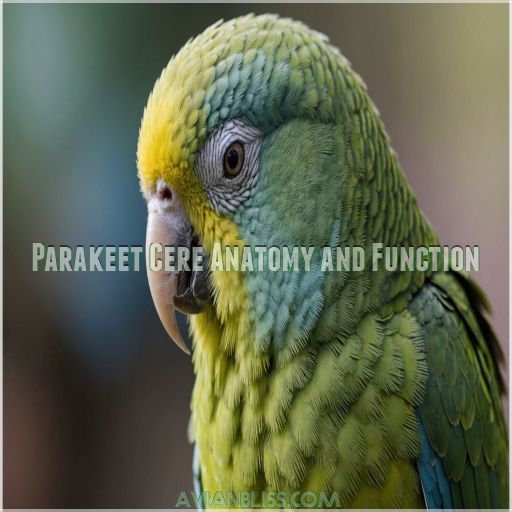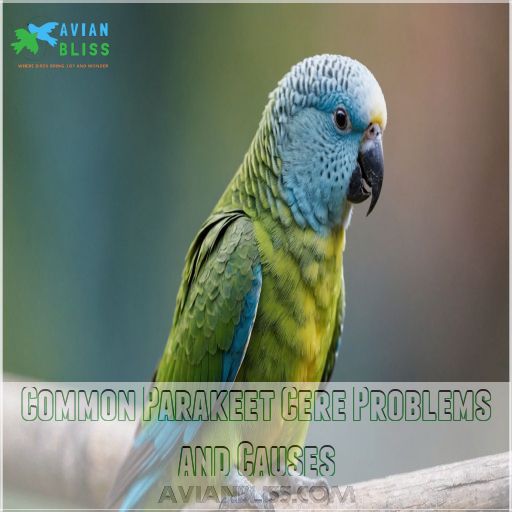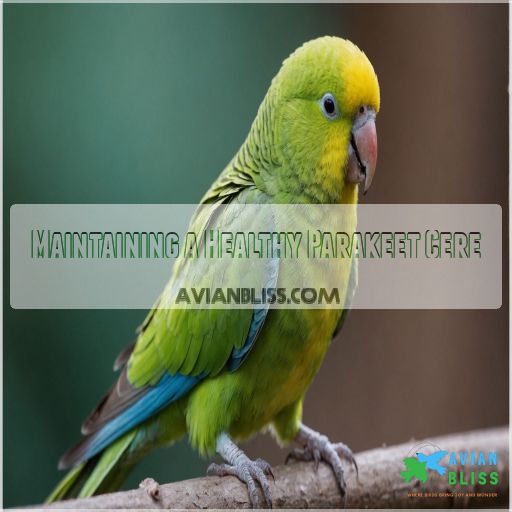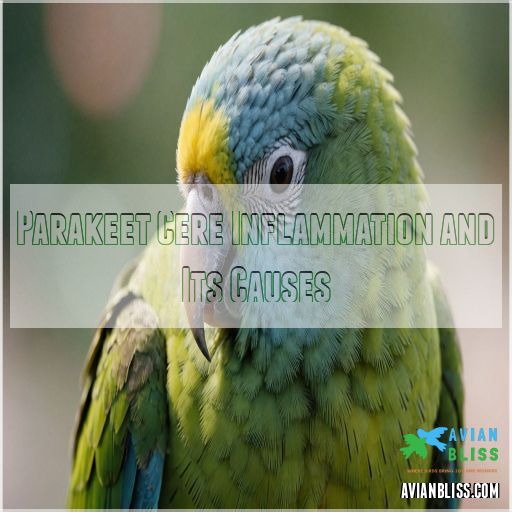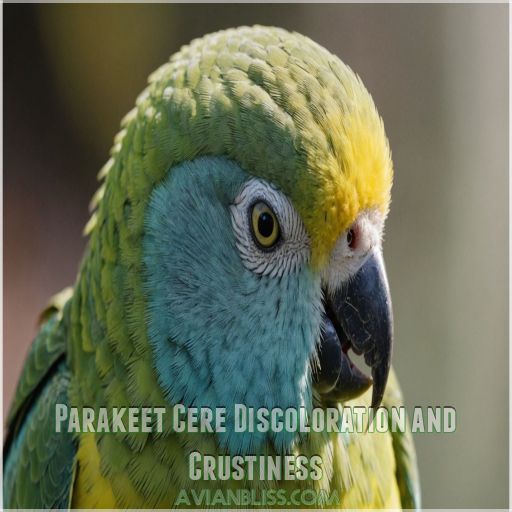This site is supported by our readers. We may earn a commission, at no cost to you, if you purchase through links.
 Your parakeet’s cere, that fleshy area above its beak, can face several issues. Common parakeet cere problems include inflammation, bleeding, dryness, and unusual growths.
Your parakeet’s cere, that fleshy area above its beak, can face several issues. Common parakeet cere problems include inflammation, bleeding, dryness, and unusual growths.
These can be caused by infections, allergies, nutritional deficiencies, or even mites. Keep an eye out for changes in color, texture, or any discharge.
A healthy cere is important for your feathered friend’s well-being, so don’t ignore these signs. Regular check-ups and a balanced diet can help prevent many issues.
Remember, your parakeet can’t tell you when something’s wrong, so you’ve got to be its watchful guardian. Curious about how to spot these problems early?
There’s more to uncover about keeping your parakeet’s cere in tip-top shape. Your parakeet’s health relies on your ability to notice and address these issues promptly, making a healthy cere crucial.
Table Of Contents
- Key Takeaways
- Parakeet Cere Anatomy and Function
- Common Parakeet Cere Problems and Causes
- Cere Color Changes and Their Meanings
- Maintaining a Healthy Parakeet Cere
- Parakeet Cere Inflammation and Its Causes
- Parakeet Cere Overgrowth and Its Causes
- Parakeet Cere Discoloration and Crustiness
- Parakeet Cere Bleeding and Its Causes
- Parakeet Cere Distortion and Unusual Growth
- Frequently Asked Questions (FAQs)
- Why does my parakeet have a dry cere?
- How do you know if a parakeet is healthy?
- Why does my parakeet’s cere color change?
- Do parakeets have a cere?
- What does an unhealthy cere look like?
- What is wrong with my budgies nose?
- Why are my budgies cere crusty?
- What is the disease on a parakeet’s beaks?
- Can a female parakeet have a blue cere?
- What causes growths or cysts above a parakeets cere?
- How does breeding affect a parakeets cere health?
- Can other parakeets damage a birds cere?
- Are cere problems in parakeets genetic or environmental?
- Conclusion
Key Takeaways
- Keep a close eye on your parakeet’s cere color and texture – it’s like a feathery mood ring that can signal health issues. A sudden change could mean anything from hormonal shifts to infections, so don’t brush it off as just a bad hair day for your bird’s beak.
- You are your parakeet’s personal health detective. Look out for symptoms like swelling, discharge, or crusty patches on the cere. If you spot anything unusual, it’s time to call in the avian experts – your vet can help decode what’s really going on with your feathered friend’s beak.
- Prevention is better than cure, so pamper your parakeet with a balanced diet rich in Vitamin A, clean living quarters, and regular vet check-ups. Think of it as a spa day for your bird’s beak – they’ll thank you with happy chirps and a healthy glow.
- Don’t panic if you notice cere changes – many issues are treatable with prompt attention. From mites to hormonal hiccups, there’s usually a solution. Just remember, you are the captain of your parakeet’s health ship, so stay vigilant and steer them towards a happy, healthy life.
Parakeet Cere Anatomy and Function
In this section, you’ll find out why your parakeet’s little nose cover, the cere, is more important than you think.
It’s like the VIP area for beak health, keeping your bird cool and hydrated.
Cere Components and Purpose
Let’s take a closer look at the parakeet’s cere—a critical component of its anatomy. The cere, located at the top of the parakeet’s beak, resembles a soft, fleshy bridge that houses the bird’s nostrils, or nares . Often, its color is more than decorative, serving as an indicator of age and sex in some species.
Made of a soft, fibrous material, the cere can change color due to various factors like health and breeding conditions . This color change can be an important indicator of the parakeet’s overall health.
Keeping an eye on your parakeet’s cere health can help ward off problems like discoloration, distortion, or inflammation, ensuring your feathered friend flies through life happily. By monitoring the cere, you can help prevent issues and ensure the parakeet’s overall well-being, allowing it to fly through life happily.
Importance of a Healthy Cere
Your parakeet’s cere is more than just a cute feature – it’s a key indicator of their overall health.
This fleshy area above the beak houses the nostrils and can reveal a lot about your feathered friend . A healthy cere should be smooth, free of discharge, and the color should match what’s typical for your bird’s age and sex.
Keep an eye out for any changes, as an inflamed, crusty, or discolored cere could signal an underlying issue like an infection or nutritional deficiency.
By staying on top of your parakeet’s cere health, you can catch problems early and keep your pet happy and thriving. A healthy cere is essential to your parakeet’s overall well-being and overall health.
Common Parakeet Cere Problems and Causes
When your parakeet’s cere isn’t in top shape, it can signal a range of issues like inflammation, bleeding, or dryness that need attention.
Don’t worry, understanding common cere problems and their causes will help keep your feathery friend happy and healthy.
Plus, who knew such a little spot could have so much drama?
It is all about keeping your parakeet happy and healthy.
Inflamed or Irritated Cere
Cere inflammation or irritation in parakeets can stem from various causes, like infections, allergies, or mites—creating a domino effect of discomfort.
See your vet if your budgie exhibits symptoms such as swelling or discharge.
Maintaining good hygiene and nutrition is key for preventing cere irritation.
Regular checkups and home remedies like keeping the cere clean can help.
Bleeding Cere
Imagine spotting blood on your parakeet’s cere—alarming, right? Often, trauma from flying into obstacles or pecking sessions with other birds is to blame . Infections or nutritional deficiencies might also wreak havoc.
Stop bleeding with gentle pressure, but persistent issues? Time for the vet!
Keep the environment safe and offer a balanced diet for prevention, as this can help prevent persistent issues.
Dry Cere
When your parakeet’s cere looks dry as a desert, it’s worth investigating. A dry cere might result from dehydration, low humidity, or nutritional deficiencies.
- Ensure hydration: Keep a fresh water source.
- Adjust diet: Incorporate fruits and veggies.
- Monitor humidity: Use a humidifier nearby.
Remember, a little care keeps their cere sunny! .
Fluid Coming From Cere
Now, let’s tackle why a parakeet’s cere might ooze fluid. It’s like catching a cold—only parakeets can’t pop a lozenge! A parakeet’s cere, located above its beak, can provide clues about its overall health.
Check out the essentials of parakeet care for tips on keeping your feathered friend in tip-top shape. Common culprits for cere fluid include infections or allergies.
Check this out:
| Symptom | Possible Cause | Treatment Options |
|---|---|---|
| Fluid discharge | Infections, mites | Vet visit, medication |
| Irritation | Allergies, dryness | Environmental change |
| Discoloration | Poor diet, illness | Nutritional adjustment |
| Hypertrophy | Tumors, overgrowth | Professional care needed |
The goal? Keep your feathered friend cere-satisfied!
Peeling Cere
A parakeet’s peeling cere can be concerning but is often manageable.
It’s primarily linked to hormonal changes, nutritional issues, or even budgie cere mites.
Regular preening habits are key to cere health, so make sure your bird has a balanced diet and access to clean water.
If peeling persists, consult a vet to rule out conditions like budgie cere hypertrophy or cancer.
Cere Overgrowth or Growth Coming From Cere
Cere overgrowth in parakeets can often resemble a bad hair day on your bird’s beak. Common culprits include lack of vitamin A, hormone imbalances, or pesky mites.
- Improve Diet: Boost Vitamin A intake.
- Visit Vet: Check for tumors or infections.
- Oil Application: Gently soften crusts.
- Reduce Stress: Minimize breeding triggers.
Regular check-ups help make sure your feathered friend stays chirpy and healthy!
Cere Color Changes and Their Meanings
Understanding cere color changes in parakeets can feel like reading a mood ring, but it’s an essential part of keeping your feathered friend healthy.
From bright blues to subtle browns, these hues can indicate everything from hormonal shifts to health issues—so let’s turn Sherlock and unravel these colorful clues together!
Normal Cere Color Changes in Juveniles
As your parakeet matures, their cere color will likely change from the juvenile pink or white hue to a more vibrant blue or purple .
This shift typically happens between 8 months to 1 year old, though some birds may go through it earlier or later.
Keep an eye on these color shifts to help determine your feathered friend’s gender.
Cere Color Changes in Adult Females
Your female parakeet’s cere might shift from brown to blue or white, signaling a change in hormonal status.
When her cere’s brown, she’s likely in breeding condition; blue or white hints she’s not.
These color swings, influenced by hormones and genetics, are normal.
If her cere becomes crusty or unusual, consult a vet for parakeet care advice.
Cere Color Changes in Adult Males
Think of your male parakeet’s cere as a colorful barometer for health and mood.
Typically, it turns a vibrant blue in maturity, signaling a healthy hormonal balance.
However, stress or health issues, like tumors, might alter this hue, turning it brown or pink.
Regular checkups help detect these changes, ensuring good well-being.
Abnormal Cere Color Changes and Their Causes
Cere color changes aren’t just part of your parakeet’s fashion statement.
They’re indicators of stress, hormonal changes, or health issues like tumors or dietary imbalances.
If your feathered friend’s cere turns unexpectedly, it’s time to see an avian vet.
Don’t let these colorful warnings flutter away unnoticed; they’re essential for understanding parakeet problems and ensuring happy, healthy companionship.
Maintaining a Healthy Parakeet Cere
Keeping your parakeet’s cere healthy isn’t rocket science; just make sure it has access to fresh water and a balanced diet.
Regular vet checkups can catch issues early.
Ensuring your feathered friend stays chirpy and vibrant!
Providing Adequate Water Intake
Maintaining a healthy cere isn’t rocket science.
Parakeets are discreet drinkers, so keep fresh water available in a clean bowl daily. They prefer shallow dishes, ideal for sipping and splashing.
Watch for dehydration signs like sticky droppings; they’re clues your feathered friend needs more hydration.
Good water habits help prevent parakeet irritation and infection . They also help with hydration and prevent dehydration signs.
Monitoring Diet to Prevent Dehydration and Acidic Saliva
Your parakeet’s diet is really important for keeping their cere healthy.
Make sure your feathered friend stays hydrated and avoids acidic saliva by feeding them a balanced diet with lots of pellets, fresh veggies, and occasional healthy treats.
Avoid giving them too many seeds, as this can lead to dehydration and cere problems, including causing cere problems.
Regular Veterinary Checkups
Think of veterinary checkups as your parakeet’s version of an annual retreat.
Regular visits to avian specialists help keep cere issues at bay. Preventative care is key—spotting potential problems before they escalate saves on hefty veterinary costs.
With health monitoring, identify any changes early.
Set a checkup frequency that suits your feathery friend’s needs and stay ahead of trouble with preventative care.
Monitoring for Signs of Infection or Irritation
Spotting signs of infection or irritation in your parakeet’s cere is like staying ahead of trouble. Look for cere swelling, color changes, or unusual discharge. Pay attention to texture and behavior. A little vigilance can keep your feathered friend chirping happily.
- Check for swelling or discharge often.
- Notice changes in cere color or texture.
- Observe unusual cere behavior.
Parakeet Cere Inflammation and Its Causes
If you’ve ever noticed your parakeet looking a bit under the weather with a puffy nose, it might be dealing with cere inflammation.
This condition can be uncomfortable and indicates sinus issues, but with the right attention, you can help your feathered friend breathe easier and get back to its cheerful chirping in no time.
Cere Inflammation Symptoms and Diagnosis
If your parakeet’s cere is puffy and swollen, it might signal a sinus infection.
You may see symptoms like lethargy, crusty texture, and even an increased pulse rate, as your feathered friend tries to hide it like a poker bluff.
Keep an eye out for any color changes or nasal discharge, which could indicate something more serious lurking under those feathers (Source).
Treatment and Prevention of Cere Inflammation
The road to recovery for your feathered friend begins with proper treatment. When dealing with cere inflammation, consult your vet for appropriate antibiotics to tackle any underlying sinus infection.
While waiting for professional care, you can try some home remedies like gently cleaning the cere with warm water.
Dietary changes, such as increasing vitamin A intake, can boost your parakeet’s immune system .
Prevention is key – regular check-ups and a clean environment will keep your budgie’s cere happy and healthy.
Underlying Causes of Cere Inflammation
Now that you know how to treat cere inflammation, let’s uncover what’s causing it in the first place.
Your feathered friend’s swollen cere could be the result of a pesky sinus infection, allergies gone wild, or even tiny mites throwing a party .
Bacteria might be the culprit, or your budgie could be stressed out.
It’s like playing detective with your bird’s nose! Remember, a happy parakeet is a healthy parakeet, so keep an eye out for these troublemakers.
Parakeet Cere Overgrowth and Its Causes
If you’ve noticed your parakeet’s cere looking unusually large or overgrown, it’s time to pay attention.
Cere overgrowth in parakeets can be a sign of underlying health issues, so understanding its causes, symptoms, and treatment options is important for your feathered friend’s well-being.
Symptoms and Diagnosis of Cere Overgrowth
Spotting cere overgrowth in your feathered friend can be tricky, but it’s key to keeping them healthy.
Watch for these telltale signs:
- A crusty or thickened appearance of the cere
- Difficulty breathing or beak breathing
- Blocked or partially obstructed nostrils
- Changes in cere color or texture
If you notice any of these symptoms, it’s time for a vet visit. Remember, your parakeet’s cere is like their nose – when it’s out of whack, they can’t breathe easy!
Treatment and Prevention of Cere Overgrowth
Once you’ve spotted cere overgrowth in your feathered friend, it’s time to take action.
Your vet might recommend trimming the excess growth or prescribing medications to address underlying issues.
To prevent future problems, make sure your parakeet’s diet is balanced and varied, not just seeds. Regular check-ups and a keen eye for changes can nip issues in the bud.
Remember, a healthy cere means a happy bird, so stay vigilant and keep those beaks in tip-top shape. Also, a balanced and varied diet is key to maintaining a healthy cere.
Underlying Causes of Cere Overgrowth
Understanding the root causes of cere overgrowth is key to keeping your feathered friend healthy.
Several factors can contribute to this condition, including hormonal imbalances, vitamin deficiencies, and even genetics . In some cases, tumors or mites might be the culprits.
Your budgie’s diet plays a vital role too – a lack of Vitamin A could be behind that crusty cere.
Remember, each parakeet is unique, so what triggers overgrowth in one bird mightn’t affect another, highlighting the importance of addressing each bird’s individual needs.
Parakeet Cere Discoloration and Crustiness
If you’ve noticed your parakeet’s cere changing color, don’t panic just yet, as a parakeet’s brown cere can be caused by various factors
.
These changes can be normal in some cases, but they might also signal underlying health issues that need your attention.
Causes of Cere Discoloration and Crustiness
Your parakeet’s cere can change color or become crusty due to various factors. It’s like a mood ring for their health!
- Diet: A seed-heavy menu might lead to nutritional imbalances
- Mites: These tiny pests can cause irritation and discoloration
- Hormones: Breeding readiness can alter cere appearance
- Tumors: In some cases, discoloration may signal an underlying growth
Stress and environmental factors can also play a role. Remember, a healthy diet and regular check-ups are your feathered friend’s best defense!
Symptoms and Diagnosis of Cere Discoloration
Spotting cere discoloration in your feathered friend can be as tricky as finding a needle in a haystack! But fear not, here’s a handy guide to help you play detective.
| Symptom | Possible Cause | Severity | Action |
|---|---|---|---|
| Brown patches | Hormonal changes | Low | Monitor |
| Crusty texture | Mites or infection | Medium | Vet visit |
| Blue to brown (males) | Potential tumor | High | Urgent vet |
| Pale or white | Vitamin A deficiency | Medium | Diet change |
Remember, a change in cere color could be your budgie’s way of saying, "Hey, something’s up!"
Treatment and Prevention of Cere Discoloration
Treating cere discoloration requires a multi-faceted approach. To get your feathered friend back in tip-top shape:
- Consult an avian vet for proper diagnosis and treatment
- Adjust diet to include Vitamin A-rich foods (Source)
- Check for and treat mites if present
- Reduce stress by providing a calm environment
Remember, prevention is better than cure! Regular check-ups, a balanced diet, and stress management can keep your parakeet’s cere healthy. If you notice any changes, don’t wing it – seek professional help promptly.
Parakeet Cere Bleeding and Its Causes
Your parakeet’s cere bleeding can be a scary sight, but don’t panic – it’s often treatable with prompt attention.
Let’s explore the common causes of cere bleeding in parakeets and what you can do to help your feathered friend feel better fast.
Causes of Cere Bleeding
Parakeet cere bleeding can be caused by a few different things.
Let’s take a look at the common culprits:
| Cause | Description | Prevention Tips |
|---|---|---|
| Trauma | Collisions with windows, mirrors, or walls | Remove hazards, secure flight area |
| Infection | Bacterial or fungal issues | Maintain hygiene, regular vet check-ups |
| Tumors | Growths in the cere area | Balanced diet, avoid toxins |
| Foreign Objects | Debris lodged in cere | Clean environment, proper filtration |
Remember, a healthy cere is a happy parakeet! Keep an eye out for these potential troublemakers.
Symptoms and Diagnosis of Cere Bleeding
You might notice your parakeet’s cere bleeding if you keep a watchful eye. Look out for visible blood, bruising, or dry blood around the nostrils.
Other telltale signs include changes in behavior, like reduced activity or fluffed feathers.
If you spot any of these symptoms, don’t wait for things to get worse. It’s really important to have your feathered friend checked by an avian vet promptly, as bleeding can indicate serious underlying issues.
Treatment and Prevention of Cere Bleeding
The bleeding-beak blues can be a real headache for parakeet parents.
To stop the flow, apply gentle pressure with a clean cloth . For persistent bleeding, a vet visit is a must.
Keep your feathered friend’s environment safe by removing sharp objects and covering mirrors. A balanced diet rich in vitamin K can help prevent future episodes.
Remember, a little TLC goes a long way in keeping your budgie’s beak in tip-top shape!
Parakeet Cere Distortion and Unusual Growth
You might notice your parakeet’s cere looking a bit off-kilter or sporting an unusual growth, which can be worrying.
Let’s explore what causes these cere distortions, how to spot them, and what you can do to help your feathered friend feel better.
Causes of Cere Distortion and Unusual Growth
Parakeet cere distortion and unusual growth can stem from various factors. Mites, like Knemidocoptes, burrow into the beak’s germinal layer, causing distorted growth (Source).
Tumors, such as carcinomas, might lead to abnormal cere development. Hyperkeratosis can result in thickened, crusty layers resembling oyster shells.
Vitamin A deficiency may contribute to cere problems. Remember, not all beak irregularities are mite-related – trauma from other birds can also cause issues.
Understanding these causes helps you stay ahead of potential cere problems and beak irregularities.
Symptoms and Diagnosis of Cere Distortion
Spotting cere distortion in your feathered friend can be tricky, but it’s really important for their health.
Keep an eye out for any unusual growths, swelling, or changes in texture. Your parakeet’s cere might develop a honeycombed appearance or crusty patches .
In severe cases, you might notice overgrown nails, indicating difficulty walking.
A hands-on exam by a vet, including blood tests, x-rays, and swabs, is the best way to diagnose these issues.
Treatment and Prevention of Cere Distortion
You’ve noticed your parakeet’s cere looks a bit off? Don’t panic!
Treatment for cere distortion often involves a multi-pronged approach.
Your vet may prescribe topical antiparasitics like moxidectin to tackle pesky mites.
For more severe cases, they might recommend softening crusts with aloe vera gel and removing obstructions to restore normal airflow.
Prevention is key – maintain proper nutrition, hygiene, and regular check-ups to keep your feathered friend’s "nose" in tip-top shape!
Frequently Asked Questions (FAQs)
Why does my parakeet have a dry cere?
Did you know 80% of parakeet health issues start with the cere?
Your feathered friend’s dry cere could be a sign of various conditions, from breeding readiness to infections.
It’s like a bird’s mood ring – always worth checking!
How do you know if a parakeet is healthy?
Look for bright eyes, clean feathers, and an active disposition in your parakeet.
A healthy bird will have a good appetite, lots of energy, and produce regular droppings.
Watch for alert behavior and balanced posture too.
Why does my parakeet’s cere color change?
A chameleon’s got nothing on your parakeet!
Your bird’s cere color changes due to hormones, age, and breeding status.
It’s nature’s mood ring, signaling reproductive readiness or seasonal shifts.
Don’t fret, it’s usually normal and healthy, and is often signaling reproductive readiness.
Do parakeets have a cere?
Parakeets do indeed have a cere – it’s the fleshy area above their beak where their nostrils are located.
This feature can change color and texture, potentially indicating your bird’s sex or health status.
What does an unhealthy cere look like?
You’ll spot an unhealthy cere if it’s changing color unexpectedly.
For males, a brown cere can signal hormonal issues or even testicular cancer.
Keep an eye out for sudden shifts or crusty textures – they’re red flags!
What is wrong with my budgies nose?
A bird in the hand is worth two in the bush, so don’t ignore your budgie’s runny nose.
It could indicate various issues like infections, allergies, or environmental irritants.
Consult a vet for proper diagnosis and treatment.
Why are my budgies cere crusty?
A crusty cere on your budgie could indicate hormonal changes, especially in females during breeding season .
It might also signal health issues like mites or injuries.
Don’t panic, but keep an eye on your feathered friend’s behavior.
What is the disease on a parakeet’s beaks?
Beak troubles in parakeets can range from overgrowth to infections.
Psittacine Beak and Feather Disease (PBFD) is a serious concern, causing beak deformities and immune system issues.
Regular check-ups help catch problems early, keeping your feathered friend’s healthy smile.
Can a female parakeet have a blue cere?
Yes, a female parakeet can have a blue cere.
It’s not always a boy’s club! When she’s not in breeding mode, her cere may be light blue or white.
Genetics play a role too.
What causes growths or cysts above a parakeets cere?
Growths or cysts above your parakeet’s cere can be caused by various factors, including hormonal imbalances, infections, or tumors.
These could appear as pink bulges or blood blisters.
Don’t panic, but do consult an avian vet promptly.
How does breeding affect a parakeets cere health?
Like a roller coaster, breeding can send your parakeet’s cere on a wild ride.
It’ll change color and texture, potentially drying out or swelling up.
You’ll want to keep a close eye on it during this time.
Can other parakeets damage a birds cere?
Other parakeets can indeed damage a bird’s cere. When squabbles break out, these little feathered friends might accidentally injure each other’s sensitive nose areas.
It’s like a bird boxing match gone wrong!
Keep an eye out for trouble.
Are cere problems in parakeets genetic or environmental?
While genetics play a role, your parakeet’s cere health is often a delicate dance between nature and nurture.
Environmental factors like diet, stress, and hygiene can greatly impact cere condition, potentially triggering or exacerbating issues, related to the cere condition .
Conclusion
Keeping an eye on your parakeet’s cere is important, preventative, and rewarding. By understanding common parakeet cere problems, you’re equipped to spot issues early and take action.
Remember, a healthy cere means a happy bird. Stay vigilant, provide proper nutrition, and don’t hesitate to consult your vet if you notice changes.
Your feathered friend relies on you for their well-being. With knowledge and care, you’ll make sure your parakeet’s cere stays in tip-top shape, allowing your companion to chirp, play, and thrive for years to come, ensuring you have a healthy cere.

